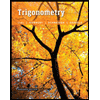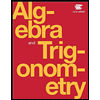2π • (2=) b. (3,-) a(-s-) d.
Trigonometry (11th Edition)
11th Edition
ISBN:9780134217437
Author:Margaret L. Lial, John Hornsby, David I. Schneider, Callie Daniels
Publisher:Margaret L. Lial, John Hornsby, David I. Schneider, Callie Daniels
Chapter1: Trigonometric Functions
Section: Chapter Questions
Problem 1RE:
1. Give the measures of the complement and the supplement of an angle measuring 35°.
Related questions
Question
for exercises 15-18, plot the points whose polar coordinates are given.
label a,b,c,d

Transcribed Image Text:**Problem 18: Polar Coordinates and Graphing**
The image contains a problem regarding polar coordinates. It provides a list of polar coordinates and a polar graph.
**Polar Coordinates:**
a. \( \left( 2, -\frac{2\pi}{3} \right) \)
b. \( (3, -\pi) \)
c. \( \left( -4, -\frac{\pi}{4} \right) \)
d. \( \left( -5, -\frac{5\pi}{6} \right) \)
**Polar Graph Description:**
The polar graph comprises a series of concentric circles centered at the origin. These circles are divided by lines radiating from the center, resembling a circular grid. These lines likely correspond to angles in radians, as specified in the problem.
Each polar coordinate corresponds to a point determined by a radius (the first number in the pair) and an angle (the second number in the pair) measured counterclockwise from the positive x-axis. Negative angles indicate a clockwise direction, and negative radii indicate a reflection across the origin. The given points can be plotted on this grid accordingly.

Transcribed Image Text:The image displays a polar coordinate grid. This type of grid is centered at the origin with concentric circles extending outward, each marked with increasing radius values. The grid has both radial and circular lines, facilitating the plotting of points in polar coordinates.
### Key Features:
1. **Concentric Circles:**
- Each circle represents a constant radius from the origin and is divided into equal radial segments.
- The circles are incrementally labeled from 0 to 10.
2. **Radial Lines:**
- Spaced angles divide the circle into equal segments, forming lines radiating from the origin.
- The angles appear to be separated by 30 degrees, intersecting the circles at points where coordinates would be calculated using polar formulas.
3. **Axes:**
- The polar grid features four main axes intersecting perpendicularly at the origin.
- These axes are aligned with 0°, 90°, 180°, and 270° directions on a circular plane, labeled with numbers indicating positive and negative directions.
This polar grid provides a framework for graphing functions or plotting data points using polar coordinates, where each point is determined by a radius and an angle.
Expert Solution
This question has been solved!
Explore an expertly crafted, step-by-step solution for a thorough understanding of key concepts.
This is a popular solution!
Trending now
This is a popular solution!
Step by step
Solved in 2 steps with 1 images

Knowledge Booster
Learn more about
Need a deep-dive on the concept behind this application? Look no further. Learn more about this topic, trigonometry and related others by exploring similar questions and additional content below.Recommended textbooks for you

Trigonometry (11th Edition)
Trigonometry
ISBN:
9780134217437
Author:
Margaret L. Lial, John Hornsby, David I. Schneider, Callie Daniels
Publisher:
PEARSON

Trigonometry (MindTap Course List)
Trigonometry
ISBN:
9781305652224
Author:
Charles P. McKeague, Mark D. Turner
Publisher:
Cengage Learning


Trigonometry (11th Edition)
Trigonometry
ISBN:
9780134217437
Author:
Margaret L. Lial, John Hornsby, David I. Schneider, Callie Daniels
Publisher:
PEARSON

Trigonometry (MindTap Course List)
Trigonometry
ISBN:
9781305652224
Author:
Charles P. McKeague, Mark D. Turner
Publisher:
Cengage Learning


Trigonometry (MindTap Course List)
Trigonometry
ISBN:
9781337278461
Author:
Ron Larson
Publisher:
Cengage Learning